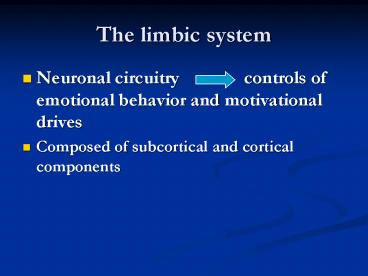The limbic system - PowerPoint PPT Presentation
1 / 40
Title: The limbic system
1
The limbic system
- Neuronal circuitry controls of
emotional behavior and motivational drives - Composed of subcortical and cortical components
2
(No Transcript)
3
Limbic System
Figure 12.18
4
limbic
5
Subcortical group
- Hypothalamus ,septum,paraolfactory
area,epithalamus,ant.thalamic nuclei,hippocampus,a
mygdala,basal gangeli
6
Limbic cortex
- Orbitofrontal coretx,subcallosal gyrous cingulate
gyrus and parahippocamp gyrous
7
(No Transcript)
8
Limbic System Emotion and Cognition
- The limbic system interacts with the prefrontal
lobes, therefore - One can react emotionally to conscious
understandings - One is consciously aware of emotion in ones life
- Hippocampal structures convert new information
into long-term memories
9
The hypothalamus not only influences how you
feel, it influences how you interpret the
consequences of those feelings.
10
(No Transcript)
11
limbic
12
(No Transcript)
13
Hypothalamic Role in Emotion
HypothalamicNuclei
VisceralAfferents
HormonalOutput
Nucleusof the Solitary Tract
TargetOrgans
AutonomicOutput
AutonomicPreganglionicNuclei
Brain StemNuclei
14
Hypothalamus
PituitaryReleasing Factors
AutonomicNervous System
Sympathetic
Adenohypophysis(Anterior Pituitary)
Neurohypophysis(Posterior Pituitary)
Parasympathetic
15
I feel fear!
16
striaterminalis
Amygdala
mtt
Anterior Nucleus
dorsal long.fasciculus
Brainstem
medial forebrainbundle
Cortex, septum
Hypothalamus
ventralroute
medialforebrainbundle
Brainstemspinal cord
Amygdala
magno(SO, PV)
parvo
post.
ant.
Pituitary
17
Hypothalamus,Major
- Hypothalamus is the most important output sorce
- It communicate with brain stem by medial
forebrain bundle ,bidirectionaly between
forebrain and brain stem
18
Hypothalamus cont.
- Controls
1-vegetative and endocrine
functions 2-behavior and
motivation
19
vegetative and endocrine functions
- Cardiovascular regulation involves
1-Post. And lateral hypothalamus area,
increase BP and HR.
2-preoptic area
,decrease BP and HR 1and
2 mediated by cardiovascular centre in the
pontile and medullary part of reticular formation
20
Body temperature regulation
- Preoptic area
21
Thermo-regulation (body temperature)
- Involves autonomic nervous, endocrine, and
skeletomotor systems - Body temperature detectors
- Peripheral skin, spinal cord, viscera
- Central anterior hypothalamus
- Body temperature effectors
- Heat retention or generation posterior
hypothalamus - Heat dissipation anterior hypothalamus
22
Thermo-regulation (body temperature)
- Heat dissipating mechanisms
- Dilation of blood vessels in the skin
- Inhibition of shivering
- Heat conserving mechanisms
- Vasoconstriction of blood vessels in the skin
- Shivering
- Increased secretion of thyroxin
23
(No Transcript)
24
Response to Cold
Response to Heat
Methods of thermo-regulation by the body
25
Regulation of body water intake
- Thirst centre,lateral hypothalamus
- Electrolyte concentrationmaking desire to drink
- Supraopticxurinary excrition due to ADH
26
Thirst
- Function of serum osmolality and blood volume
- Osmotic receptors in the hypothalamus
- Volume receptors in the right atrium of the heart
and great veins - Vasopressin release from hypothalamus
- Increases water reabsorption from the kidney
- Inhibited by ethanol
27
Circadian Rhythm
- Oscillations during the course of the day
- Corticosteriods
- Feeding and drinking behavior
- Growth hormone secretion
- Lesions of the suprachiasmatic nuclei of the
hypothalamus disrupts these oscillations
28
Control of Feeding
29
Feeding
- Complex interaction of many systems
- Regulation of energy metabolism by the
Ventromedial and Lateral nuclei of the
hypothalamus - Physical Lesions produce hyperphagia and obesity
or reduced attention to food. - Amygdala may also be involved indirectly
- Lesions produce hyperphagia-like symptoms
- Ventromedial hypothalamic lesions also cause
increased insulin secretion Obesity.
30
(No Transcript)
31
(No Transcript)
32
Feedback Mechanisms Controlling Feeding
- Feedback from gut hormones
- e.g. Cholecystokinin
- Released from small intestine in response to
feeding - Inhibits or suppresses feeding
33
Uterine contraction and milk ejection
- Oxytocin stimulation by PARAVENTRICULAR
34
(No Transcript)
35
(No Transcript)
36
???? ??????? ? ?????? ?? ?? ????? ????? ???
37
???????? ???? ????? ??????
38
???????? ???? ???? ???????
39
??????? ?????? ???????
40
Hippocampus circuit
- Ent. cortex From perforant To dentate gyrous
mossy fiber cA3 schaffer collaterals cA1 to
subiculum to ento cortex

